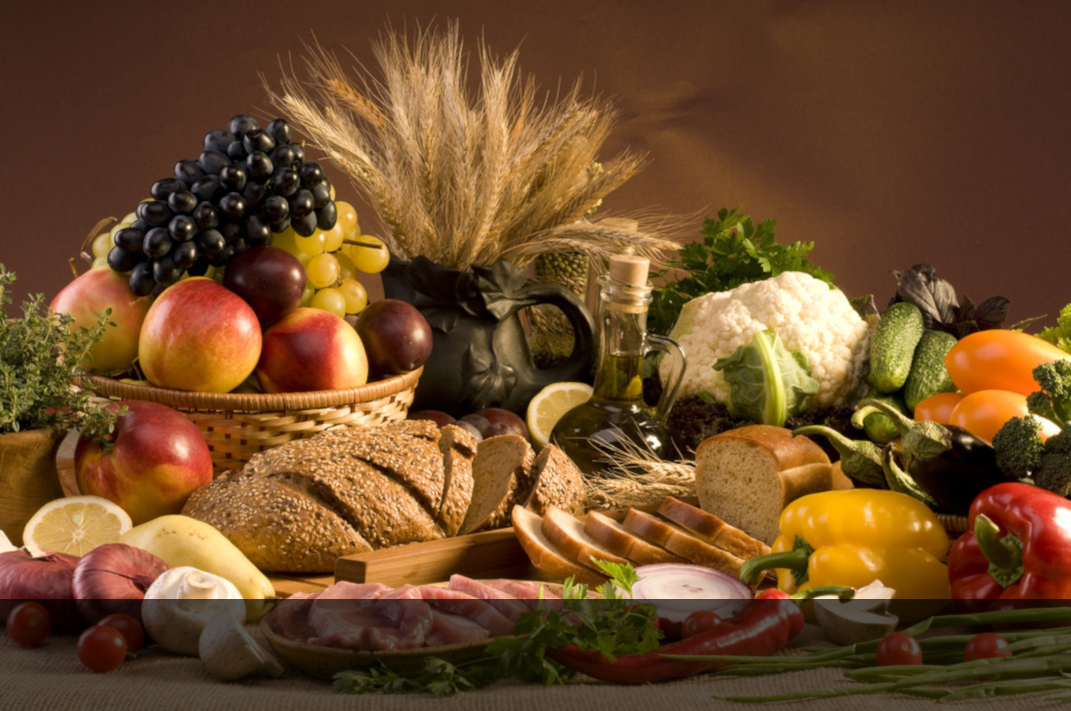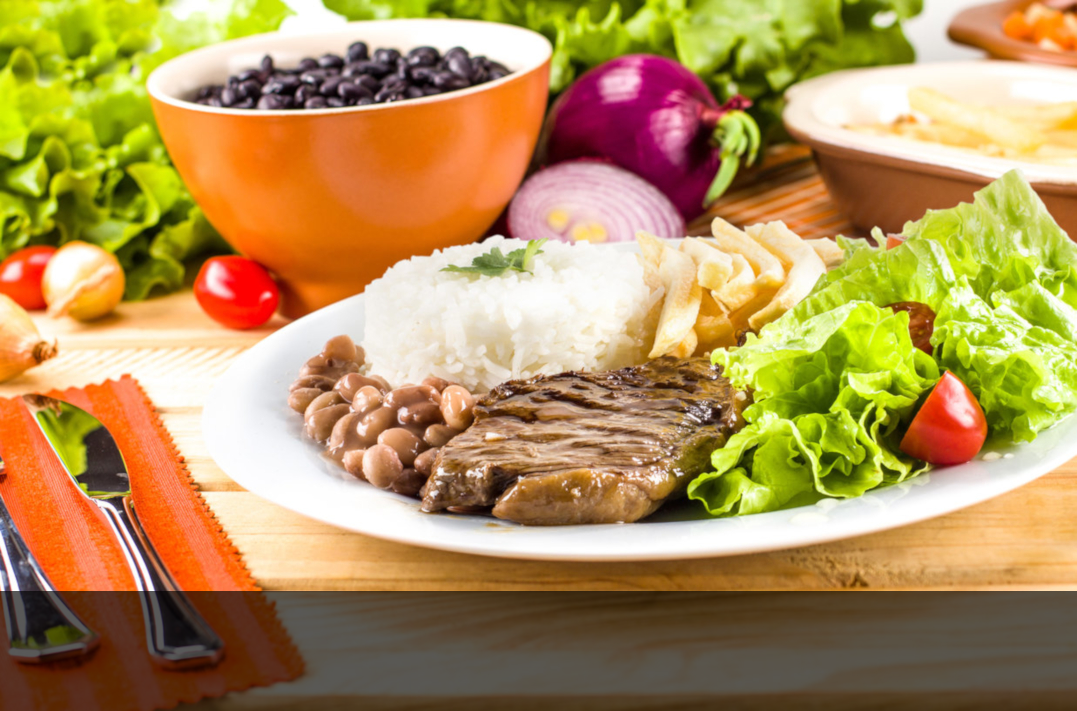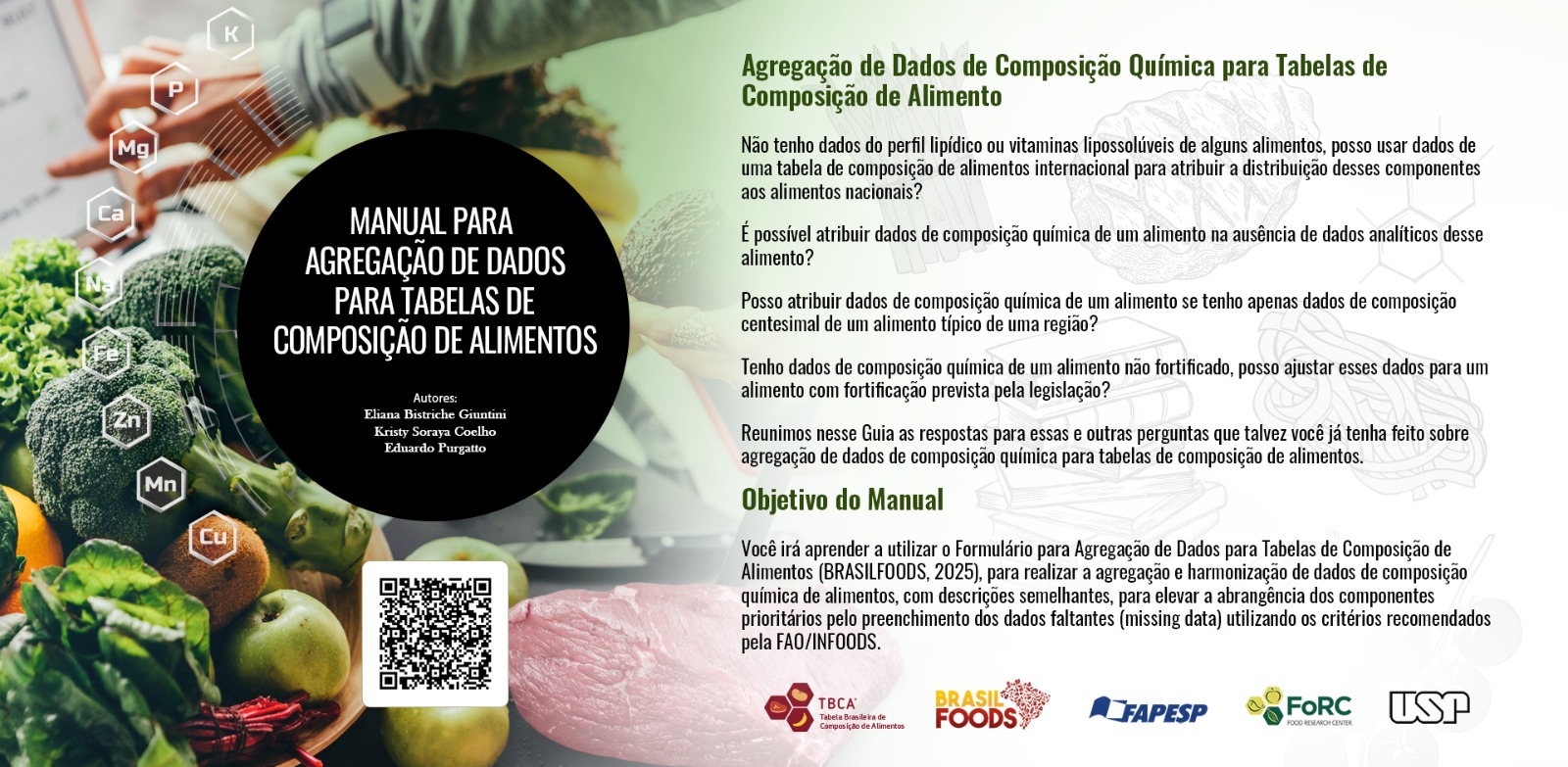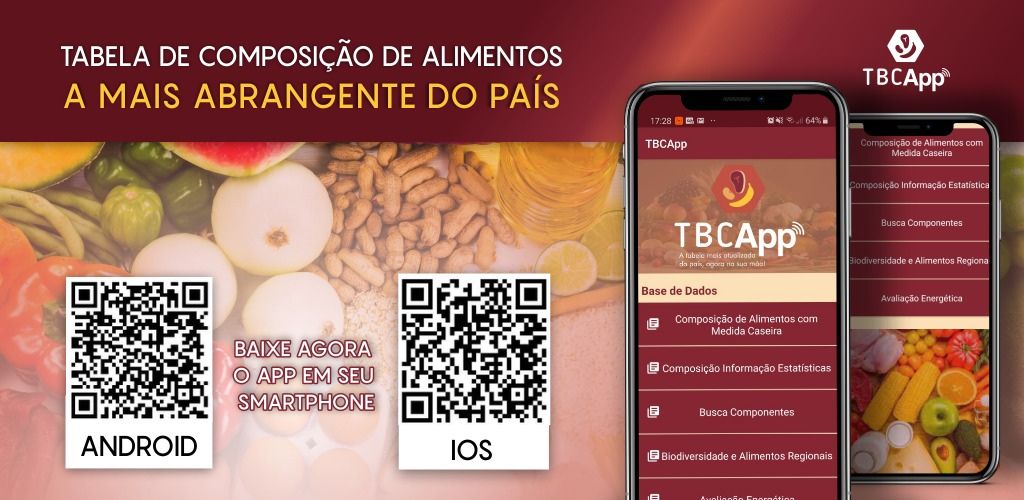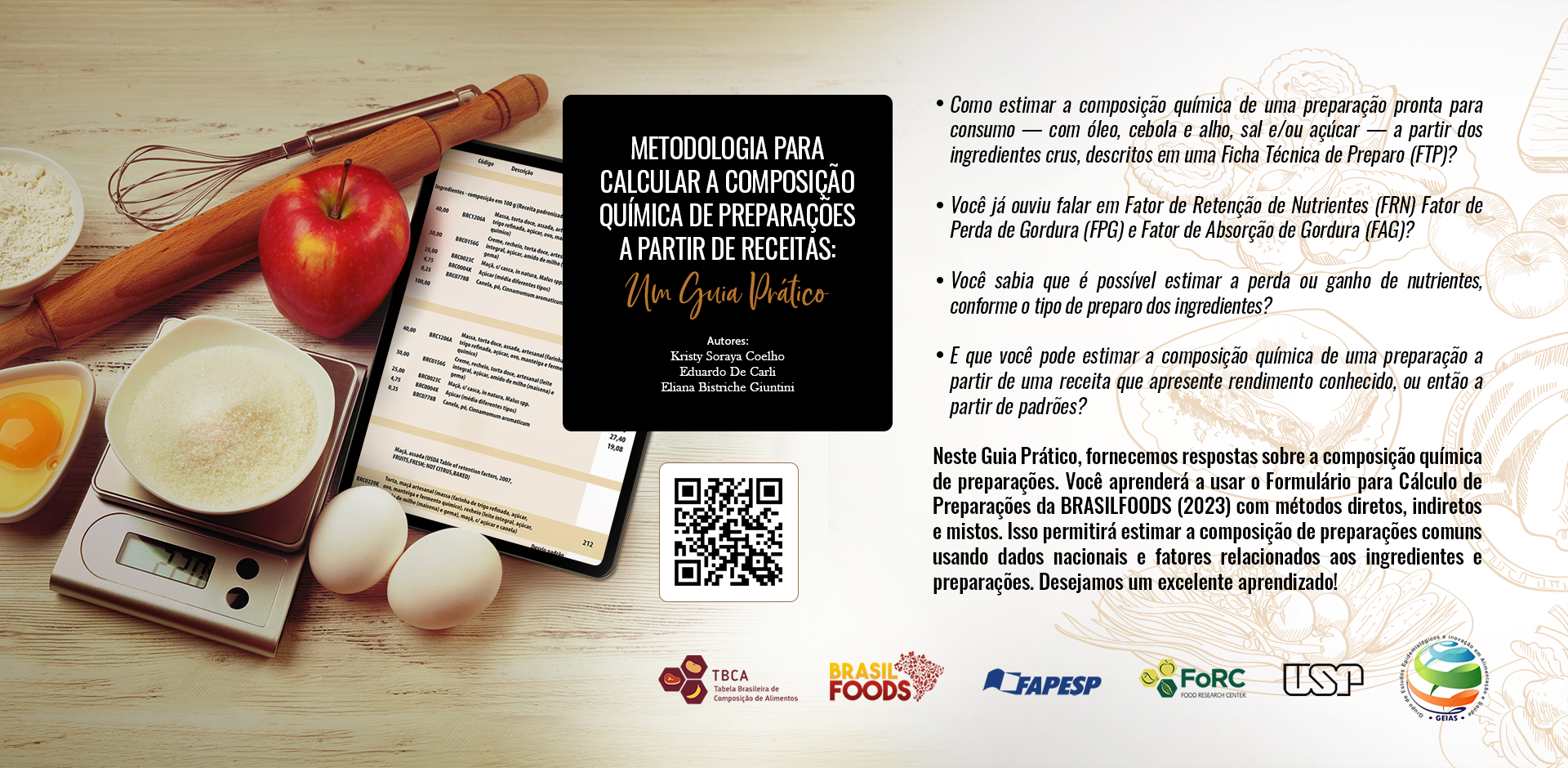Introduction
As of 2013, the Brazilian Network of Food Data Systems (TBCA) is being developed in an integrated manner between the Brazilian Network of Food Data Systems (BRASILFOODS), the University of São Paulo (USP), and the Food Research Center (FoRC/CEPID/ FAPESP, Process - 2013/07914-8).
The TBCA presents two different databases, one with original analytical data related to foods from Brazilian biodiversity and regional foods, and the other with information on the content of components of the most consumed foods in Brazil, intending to allow the evaluation of the intake of nutrients and facilitate the planning of meal plans.
The information from the TBCA databases was obtained both through directly analyzing foods in laboratories at the Department of Food and Experimental Nutrition of the Faculty of Pharmaceutical Sciences, USP, and by compiling information from analytical data for Brazilian foods from publications, dissertations, theses, internal data from other laboratories, analytical reports made available by food industries, and other tables.
Data inclusion in the TBCA involves several aspects, such as the complete description of the food or product, sampling plan, analytical methods, and quality of the analysis procedures. This information is compiled using a standardized form resulting in detailed documentation about the food and the sampling and analysis procedures.
History
Considering the importance of data on food composition, the United Nations University (UNU) recommended, in 1984, creating the International Network of Food Data Systems (INFOODS) under the coordination of the Food and Agriculture Organization of the United Nations (FAO). This network aims to stimulate and coordinate efforts to improve the availability and quality of food composition data.
Since 1992, INFOODS has been proposing new guidelines and criteria for the area of food composition, publishing guides and manuals with protocols to be used in generating and compiling data to expand communication and exchange of information between laboratories and institutions for national and international research.
In Brazil, the Brazilian Food Composition Data Network (BRASILFOODS) was created in 1984, headquartered at the USP, as part of the Latin American Food Composition Data Network (LATINFOODS), which follows the quality guidelines recommended by INFOODS.
Motivated by INFOODS, especially Dr. Nevin Scrimshaw from UNU and Dr. Ricardo Bressani from LATINFOODS, the Integrated Food Composition Project was created in Brazil in 1989 under the coordination of Prof. Franco Maria Lajolo from the Department of Food and Experimental Nutrition at the Faculty of Pharmaceutical Sciences, USP. The project informally convened two dozen Brazilian researchers and professionals to discuss and conduct studies to improve the quality of data on the chemical compositions of foods. This project was later incorporated by BRASILFOODS. Since 2013, BRASILFOODS has been working collaboratively with the Food Research Center, developing and updating the TBCA, which has become one of the FoRC axes, since the chemical compositions of foods can be directly associated with the health-disease binomial, and it is also necessary for developing various activities.
As a result of the joint efforts of the project and BRASILFOODS, the TBCA was created in 1998 to centralize information on the chemical compositions of Brazilian foods. The TBCA data profile, with each new version, reflects the evolution of the area’s development in the country in both the analytical and compilation aspects.
Version 1.0 (1998) was released with data on the centesimal composition (CC) of 300 foods; Version 3.0 (2001) also had information on resistant starch (RS), dietary fiber (DF), fatty acids and cholesterol, and carotenoids in addition to 696 CC data points. Version 4.0 (2005) had 1,205 CC data points, a food search system (Portuguese, English, scientific name), information on household measures, and relevant publications in the area. Version 5.0 (2008) also presented data on glycemic response and carbohydrate profile in addition to updated data on CC, DF, RS, vitamin A and carotenoids, fatty acids, and cholesterol. Version 6.0 (2017) presented two databases, one with original data related to foods from Brazilian biodiversity (BD-B – Portuguese acronym) and another (Database for the Evaluation of Food Intake – BD-AIN – Portuguese acronym) with information on the contents of 34 components of 1,900 foods. Version 7.0 contains data for over 1,200 foods in BD-B and over 3,400 foods in BD-AIN. Version 7.2 contains data on more than 5,700 foods, with more than 4,000 preparations, of different types of food (preparation with texture alteration, gluten-free, lactose-free, and vegan and vegetarian) to allow the evaluation of the nutrient intake and facilitate the assessment of food consumption, in addition to menu preparation.
General information
The TBCA comprises two databases and complementary tables, as described below.
TBCA – Nutrient Intake Assessment (TBCA BD-AIN – Portuguese acronym): Prepared based on analytical data for food and industrialized products in the Brazilian market, this provides the complete profile of information about its CC, vitamins, and minerals and identifies the addition of salt and sugar in preparations, aiming to evaluate nutrient intake. It includes the foods most consumed by the Brazilian population. These are primarily national data, which can be analytical, calculated, or obtained from other sources, in this case, adjusted for moisture or lipids of the food of origin.
Standard recipes, commonly used by the Brazilian population and available in the literature (Fisberg; Slater-Villar, 2002, Araújo; Guerra, 2008, Pinheiro et al., 2008, Bombem et al., 2012, Magalhães; Rodrigues, 2015), or standards were used (salt, sugar, oil, onion, and garlic, quantity/proportion of ingredients – cereals, vegetables, fish and seafood, meat, eggs, legumes) to estimate the chemical compositions of the preparations (TBCA, 2023). All estimates calculated were based on how foods/preparations are consumed, that is, with oil, seasonings, salt, and sugar.
For the estimates, the conversion factor (or cooking yield factor) was applied to the total preparation, while the nutrient retention factors were used individually for each ingredient, as instructed by Reinivuo et al. (2009). The conversion factors (or cooking yield factors) were based on the literature (Bergström, 1994; Bognár, 2002; Matthews and Garrison, 1975; USDA, 2014) or our own estimates, while the nutrient retention factors (Bognár, 2002; USDA, 2007; Vásquez-Caicedo et al., 2008) were compiled from the literature according to the food type and preparation. The document from the National Health Surveillance Agency (ANVISA) for the use of salt in collective restaurants was used as a reference (ANVISA, 2014) to determine the amount of salt added to the calculated preparations, considering the food group.
Three methods were used for the estimates:
- Direct method – used as instructed by Greenfield and Southgate (2003). The calculation is performed using national analytical data on foods/ingredients with simple preparation (for example, boiled, grilled, or roasted vegetables) from TACO (2011) and data from other publications, used proportionally, to estimate 100 g of final preparation ready for consumption; for this method, it is unnecessary to apply conversion factors (or cooking yield factor) and nutrient retention (nutrient retention factor). Some examples of its application are cereals, pasta, meat, and legumes, with or without other added ingredients, such as vegetables, sauces, seasonings, and salt (rice with broccoli, pasta with sauce, and meat with potatoes).
- Indirect method – used as instructed by Machackova et al. (2018). This is used when no information is available about the prepared ingredient; for this method, conversion (or cooking yield factor) and nutrient retention (nutrient retention factor) are applied. The chemical composition estimates are based on the initial and final weights and the ingredients containing the highest amount of moisture. Some examples of its application are in preparations such as cakes, bread, and fried foods.
- Mixed method – used in situations where preparations use ingredients that undergo more than one preparation method, that is, application of the nutrient retention factor to specific ingredients, such as a sandwich that has some of its ingredients heated and some in natura (bread, cold cuts, and vegetables; Giuntini et al., 2019).
- Bergström, L. Nutrient losses and gains in the preparation of foods 1994.
- Bognár, A. Tables on weight yield of food and retention factors of food constituents for the calculation of nutrient composition of cooked foods (dishes). Bundesforschungsanstalt für Ernährung: 2002.
- FAO. FAO/INFOODS global food composition database for fish and shellfish, version 1.0 - uFiSh1.0. Rome, 2016.
- Magalhães, S. G.; Rodrigues, E. L. Fichas de preparações e análise do valor nutricional. Rio de Janeiro: Rubio, 2015. 288p.
- Matthews, R. H.; Garrison, Y.J. Food yields summarized by different stages of preparation. Washington, D.C.: 1975.
- Pinheiro, A. B. V. et al. Tabela para avaliação de consumo alimentar em medidas caseiras. 5. ed. São Paulo: Atheneu, 2004. 131p.Paulo: Atheneu, 2004. 131 p.
- USDA. U. S. Departmenr of Agriculture. USDA Table of Nutrient Retention Factors,Release 6. Natl Acad Press 2007:18.
- USDA. U. S. Department of Agriculture. USDA Table of Cooking Yields for Meat and Poultry, release 2 2014:1–30.
- Vásquez-Caicedo, A. L.; Bell, S.; Hartmann, B. Report on collection of rules on use of recipe calculation procedures including the use of yield and retention factors for imputing nutriente values for composite foods 2008:184.
TBCA – Biodiversity and Regional Food (TBCA BD-B – Portuguese acronym): This database results from compiling data on the chemical compositions of foods belonging to BD-B and typical dishes from various regions of the country. It presents only original analytical information without data aggregation or attribution. The indicators used for food selection were as follows (FAO, 2016): (i) food described at variety/cultivar/race level; (ii) wild food, according to how the analyzed sample was obtained (food obtained directly from nature); and (iii) food classified as underutilized according to the INFOODS List of Underutilized Species (FAO/INFOODS, 2013).
- FAO/INFOODS - Food and Agriculture Organization/ International Network of Food Data Systems. INFOODS List of underutilized species contributing to the Nutritional Indicators for Biodiversity version 1.2. Dec 2013a [cited 2014 Dec 10]. Available from: http://www.fao.org/infoods/infoods/food-biodiversity.
- FAO - Food and Agriculture Organization. FAO/INFOODS Food Composition Database for Biodiversity Version 3.0 – BioFoodComp3.0. FAO, Rome. [cited 2016 Apr 15]. Available from: http://www.fao.org/infoods/infoods/tables-and-databases/faoinfoods-databases/en.
Complementary Tables: These contain analytical data on specific components available in .pdf format for download (the available file information is only in Portuguese) - Under implementation:
- Carbohydrate profile (Download);
- Glycemic response (Download);
- Flavonoids (Download);
- Vitamin A and carotenoids (Download).
The content of each component shown is expressed per 100 g of the edible portion on a whole basis. Small differences between the nutritional information values on labels may be found, compared with data on the same foods present in the TBCA, due to the formulation and raw material adjustments. Additionally, food labeling follows specific legislation – RDC No. 429, of 10/8/2020 – which determines that the value must be expressed per portion (in grams and home measure) and per 100 g and provides for the respective rounding (IN No. 75, of 10/8/2020).
Several companies have collaborated for the TBCA by sending data on the chemical compositions of foods, accompanied by detailed analytical reports. Some of these foods mentioned may not be available on the market because they are seasonal, regional, or about to be discontinued.
How to Cite
The disclosure of data is encouraged for non-commercial purposes, and it is necessary to cite the source:
Brazilian Food Composition Table (TBCA). University of São Paulo (USP). Food Research Center (FoRC). Version 7.3. São Paulo, 2025. [Access at: xxxx]. Available at http://www.fcf.usp.br/tbca.
For commercial purposes, it is necessary to contact the coordinators.
When data are used to calculate nutritional information, citation of the source is waived.
Total or partial reproduction of the material is prohibited. If material information is used, it is mandatory to cite the source. Marketing is forbidden. Total or even partial alteration of the content is prohibited (Creative Commons NonCommercial-NoDerivatives [CC BY-NC-ND 4.0]).
Credits
Responsible committee
Department of Food and Experimental Nutrition FCF-USP/FoRC Researchers
- Franco M. Lajolo (Coordinator).
- Elizabete Wenzel de Menezes (Vice coordinator).
- Eduardo Purgatto (Academic Coordinator) epurgatt@gmail.com.
Faculty of the Department of Food and Experimental Nutrition FCF-USP/FoRC Researchers
- Bernadette Dora Gombossy de Melo Franco.
- Neuza Mariko Aymoto Hassimotto.
Current Employees
- Eliana Bistriche Giuntini – Researcher at FoRC.
- Kristy Soraya Coelho – Researcher at FoRC.
Web Design and Platform Development
- OBTZ-Tech.
Former collaborators
- Adriana Elisa Canzio – aluna de graduação da FCF-USP
- Alexandra Tavares de Melo – aluna de graduação da Faculdade de Nutrição FSP-USP.
- Aline de Oliveira Santos – técnica do laboratório de Química, Bioquímica e Biologia Molecular de Alimentos II.
- Ana Laura Alves – aluna de graduação do Centro Universitário São Camilo.
- Ana Tereza Ratto – aluna de Pós-Graduação do PRONUT FCF/FEA/FSP-USP.
- Awdrey Dias Vasconcelos Silva – aluna de graduação em Nutrição na Universidade Nove de Julho.
- Cindy María Hidalgo Vísquez – aluna de Pós-graduação em Sistema Integrados em Alimentos FCF/FZEA/ESALQ-USP.
- Beatriz Rosana Cordenunsi – docente do Departamento de Alimentos e Nutrição Experimental FCF-USP.
- Edilene Maria Queiroz Araújo – docente Universidade do Estado da Bahia (UNEB).
- Eduardo Di Carli – aluno da Pós-graduação em Ciência dos Alimentos FCF-USP.
- Eliana Rodrigues Mazzini – aluna de Pós-graduação em Ciência dos Alimentos FCF-USP.
- Érica Oliveira Rocha – aluna de graduação da FCF-USP.
- Eun Yee Hong – aluna de graduação da Faculdade de Nutrição FSP-USP.
- Fábio Augusto R. Gonçalves – aluno de graduação da FCF-USP (Web master versão 1-3).
- Flávia Biet – aluna de graduação da Faculdade de Nutrição FSP-USP.
- Fernanda Grande – aluna de Pós-Graduação do PRONUT FCF/FEA/FSP-USP.
- Giuliana Monteiro Carneiro – aluna de Pós-graduação em Sistema Integrados em Alimentos FCF/FZEA/ESALQ-USP.
- Julia Nascimbem Blaser – aluna de Pós-graduação em Sistema Integrados em Alimentos FCF/FZEA/ESALQ-USP.
- Hamilton Vivas da Silva Filho – graduado em Nutrição pela Universidade do Estado da Bahia (UNEB).
- Juliana de Almeida Egas Negrini – aluna de graduação de Nutrição FSP-USP.
- Juliana Godoy Lucena – aluna de graduação da Faculdade de Nutrição FSP-USP.
- Lúcia Caruso – aluna de Pós-Graduação do PRONUT FCF/FEA/FSP-USP.
- Mai Namekata Takahashi – aluna de graduação da Faculdade de Nutrição FSP-USP.
- Maria Cristina Mendes Matuiama – aluna de graduação da Faculdade de Nutrição FSP-USP.
- Maria Stella Bonin Ito – aluna de Pós-graduação em Ciência dos Alimentos FCF-USP.
- Marilene de Vuono C. Penteado – docente do Departamento de Alimentos e Nutrição Experimental FCF-USP.
- Marsia Dolores Serrano Sansón – nutricionista (Universidad Vasco de Quiroga).
- Milana Cara Tanasov Dan – aluna de Pós-graduação em Ciência dos Alimentos FCF-USP.
- Nelaine Cardoso dos Santos – aluna de Pós-Graduação do PRONUT FCF/FEA/FSP-USP.
- Samira Bernardino Ramos do Prado – aluna de Pós-graduação em Ciência dos Alimentos FCF-USP.
- Talita Santana de Jesus – graduada em Nutrição pela Universidade do Estado da Bahia (UNEB).
- Tássia do Vale Cardoso Lopes – aluna de Pós-Graduação do PRONUT FCF/FEA/FSP-USP.
- Tullia M. C. C. Filisetti – docente do Departamento de Alimentos e Nutrição Experimental FCF-USP.
- Ursula M. Lanfer Marquez – docente do Departamento de Alimentos e Nutrição Experimental FCF-USP.
- Yona Hopkins do Carmo Fonseca – aluna de graduação da Faculdade de Nutrição FSP-USP.
Thanks
To the Computer Laboratory of the Faculty of Pharmaceutical Sciences of the University of São Paulo (LABINFO)
- Luís Alberto V. Gioso, Auriluce M. Oliveira, Renato Flamini.
To the following funding bodies: FAO, CAPES, CNPq, FoRC, and FAPESP;
To the food industries and laboratories that collaborated in providing data.
Address
Department of Food and Experimental Nutrition.
Faculty of Pharmaceutical Sciences (University of São Paulo).
Avenida Professor Lineu Prestes, 580 – Block 14.
CEP 05508-900 – University City – São Paulo – SP – Brazil.
Phone: +55 11 3091-2482 – Fax: +55 11 2648-0677.
FoRC – Food Research Center
Rua do Lago, 250 – Ed. Semi Industrial, Block C – Food Engineering Laboratory.
Zip code 05508-080 – Cidade Universitária – São Paulo – SP.
Publications
Main publications related to BRASILFOODS and INFOODS
Coelho KC, Carli ED, Giuntini EB. Metodologia para cálculo da composição química de preparações a partir de receitas: um Guia Prático. São Paulo: Ed. dos Autores; 2023a. 186p. ISBN: 978-65-00-77776-5 [ebook]
Coelho KS, Giuntini EB, Grande F, Dias JS, Purgatto E, Franco BDGM, et al. Brazilian Food Composition Table (TBCA): development and functionalities of the online version. J Food Compos Anal. 2019;84:103287(6 p.) doi.org/10.1016/j.jfca.2019.103287..
Grande F, Giuntini EB, Coelho KS, Purgatto E, Franco BDGM, Lajolo FM, Menezes EW. Biodiversity food dataset: Centralizing chemical composition data to allow the promotion of nutrient-rich foods in Brazil. Matern Child Nutr. 2020;16(S3):e13005 (9 p.) doi.org/10.1111/mcn.13005
Giuntini EB, Coelho KS, Grande F, Marchioni DML, De Carli E, Sichieri R, et al. Brazilian Nutrient Intake Evaluation Database: An essential tool for estimating nutrient intake data. J Food Compos Anal. 2019;83:103286 (7 p.) doi.org/10.1016/j.jfca.2019.103286
Grande F, Giuntini EB, Coelho KS, Menezes EW. Elaboration of a standardized dataset for foods fortified with iron and folic acid in Brazil. J Food Compos Anal. 2019;83:103285 (7 p.) doi.org/10.1016/j.jfca.2019.103285
Giuntini EB, Menezes EW. Fibra alimentar. In: ILSI ed. Série de Publicações ILSI Brasil - Funções Plenamente Reconhecidas de Nutrientes. vol. 18. 2a ed. São Paulo: ILSI, 2011. 67 p. [citado 2020 dez 20]. Disponível em: ILSI / Série: Funções Plenamente Reconhecidas de Nutrientes (ilsibrasil.org).
Menezes EW, Grande F, Giuntini EB, Lopes TVC, Dan MCT, Prado SBR, et al. Impact of dietary fiber energy on the calculation of food total energy value in the Brazilian Food Composition Database. Food Chem. 2016;193:128-33. doi.org/10.1016/j.foodchem.2015.01.051
Grande F, Giuntini EB, Lajolo FM, Menezes EW. How do calculation method and food data source affect estimates of vitamin A content in foods and dietary intake? J Food Compos Anal. 2016;46:60-9. doi.org/10.1016/j.jfca.2015.11.006
Menezes EW, Grande F, Giuntini EB, Lopes TVC, Dan MCT, Prado SBR, et al. Impact of dietary fiber energy on the calculation of food total energy value in the Brazilian Food Composition Database. Food Chem. 2016;193:128-33. doi.org/10.1016/j.foodchem.2015.01.051
Prado SBR, Giuntini EB, Grande F, Menezes EW. Techniques to evaluate changes in the nutritional profile of food products. J Food Compos Anal. 2016;53:1-6, doi.org/10.1016/j.jfca.2016.08.007
Lopes TVC, Cyrillo DC, Giuntini EB, Lajolo FM, Menezes EW. Tabela brasileira de composição de alimentos - USP: Compilação de dados a serviço do bem público. Arch Latinoam Nutr. 2015;65:186-92. Disponível em: scielo.org.ve/scielo.php?script=sci_arttext&pid=S0004-06222015000300008
Lopes TVC, Giuntini EB, Dan MCT, Menezes EW. Compilation of mineral data: Feasibility of updating the food composition database. JFood Comp Anal. 2015;39:87-93. doi.org/10.1016/j.jfca.2014.12.002
Blanco AM, Pablo S, Samman N, Ariza JS, Masson L, Nunez L, Menezes EW. LATINFOODS activities and challenges during the period of 2009-2012. Arch Latinoam Nutr. 2014;64: 206-14.
The Food Monitoring Group. Progress with a global branded food composition database. Food Chem. 2013;140:451-7. doi.org/10.1016/j.foodchem.2012.10.065
Menezes EW, Giuntini EB, Dan MCT, Sardá FAH, Lajolo FM. Codex dietary fibre definition - Justification for inclusion of carbohydrates from 3 to 9 degrees of polymerisation. Food Chem. 2013;140:581-5. doi.org/10.1016/j.foodchem.2013.02.075
Menezes EW, Lopes TVC, Mazzini ER, Dan MCT, Godoy C, Giuntini EB. Application of Choices criteria in Brazil: Impact on nutrient intake and adequacy of food products in relation to compounds associated to the risk of non-transmissible chronic diseases. Food Chem. 2013;140:547-52. doi.org/10.1016/j.foodchem.2013.02.031
Dunford E, Webster J, Metzler AB, Czernichow S, Ni Mhurchu C, Wolmarans P, et al. International collaborative project to compare and monitor the nutritional composition of processed foods. Eur J Prev Cardiol. 2012;19:1326-32. dx.doi.org/10.1177/1741826711425777
Giuntini EB, Menezes EW. Fibra alimentar. In: ILSI ed. Série de Publicações ILSI Brasil - Funções Plenamente Reconhecidas de Nutrientes. vol. 18. 1a ed. São Paulo: ILSI, 2011. 23 p. [citado 2020 dez 20]. Disponível em: ILSI / Série: Funções Plenamente Reconhecidas de Nutrientes (ilsibrasil.org)
Menezes EW, Santos NC, Giuntini EB, Dan MCT, Genovese M I, Lajolo FM. Brazilian flavonoid database: Application of quality evaluation system. J Food Compos Anal. 2011;24:629-36. doi.org/10.1016/j.jfca.2010.09.004
Menezes EW, Giuntini EB, Dan MCT, Santos NC, Melo AT, Lajolo FM. Brazilian Network of Food Data Systems and LATINFOODS Regional Technical Compilation Committee: Food composition activities (2006 - 2009). J Food Compos Anal. 2011;24:678-81. doi.org/10.1016/j.jfca.2010.09.003
Menezes EW. 7th International Food Data Conference: Food composition and biodiversity. J Food Compos Anal. 2009;22:359-60. doi.org/10.1016/j.jfca.2009.04.004
Menezes EW, Giuntini EB, Dan, M.; Lajolo FM. New information on carbohydrates in the Brazilian Food Composition Database. J. Food Comp Anal. 2009;22:446-52. doi.org/10.1016/j.jfca.2009.02.001
Menezes EW, Giuntini EB, Lajolo FM, Moron, C. Latinfoods: Food composition activities in Latin America (2004-2006). J Food Compos Anal. 2007;20:704-8. doi.org/10.1016/j.jfca.2006.04.006
Giuntini EB, Lajolo FM, Menezes EW. Composição de alimentos: um pouco de história. Arch Latinoam Nutr. 2006;56(3): 295-303. Disponível em: scielo.org.ve/scielo.php?script=sci_arttext&pid=S0004-06222006000300014
Giuntini EB, Lajolo FM, Menezes EW. Tabela Brasileira de Composição de Alimentos TBCA-USP (Versões 3 e 4) no contexto internacional. Arch Latinoam Nutr. 2006; 56(4):366-74. Disponível em: scielo.org.ve/scielo.php?script=sci_arttext&pid=S0004-06222006000400009
Menezes EW, Ratto AT, Giuntini EB, Lajolo FM. Composição de alimentos: compilação e uniformização de estruturas para intercâmbio de dados. Braz J Food Technol. 2005;8(1):25-33. Disponível em: bj.ital.sp.gov.br/artigos/brazilianjournal/free/p05183.pdf
Menezes EW, Mello AT, Lima GH, Lajolo FM. Measurement of carbohydrates components and their impact on energy value of foods. J. Food Comp Anal. 2004;17(3-4):331-8. doi.org/10.1016/j.jfca.2004.03.018
Arabbi PR, Genovese MI, Lajolo FM. Flavonoids in vegetable foods commonly consumed in Brazil end estimated by the brazilian population. J Agric Food Chem. 2004;52:1124-31. doi.org/10.1021/jf0499525
Menezes EW, Giuntini EB, Lajolo FM. A questão da variabilidade e qualidade de dados de composição de alimentos. NUTRIRE Rev Soc Bras Alim Nutr. 2003;26:63-76.
Giuntini EB, Lajolo FM, Menezes EW. Potencial de fibra alimentar em países ibero-americanos: alimentos, produtos e resíduos. Arch Latinoam Nutr. 2003;53(1):14-20. Disponível em: scielo.org.ve/scielo.php?script=sci_arttext&pid=S0004-06222003000100002
Giuntini EB, Ratto AT, Lajolo FM, Menezes EW. Tabela brasileira de composição de alimentos: TBCA-USP versão 2003. Rev Bras Cienc Farmac. 2003;39(3):137-40.
Ratto AT, Giuntini EB, Lajolo FM, Menezes EW. Formulário para compilação de dados de composição de alimentos - TBCA-USP. Rev Bras Cienc Farmac. 2003;40(3): 127-9.
Menezes EW, Gonçalves, F. A. R.; Giuntini EB, Lajolo FM. Brazilian food composition database: Internet dissemination and other recent developments. J. Food Comp Anal. 2002;15(4):453-64. doi.org/10.1006/jfca.2002.1083
Rosin PMP, Lajolo FM, Menezes EW. Measurement and characterization of dietary starches. J Food Compos Anal. 2002;15(4):367-77. doi.org/10.1006/jfca.2002.1084
Lajolo FM, Saura-Calixto F, Wittig de Penna E, Menezes EW. Fibra dietética en Iberoamérica: Tecnología y salud. Obtención, caracterización, efecto fisiológico y aplicación en alimentos. Projeto CYTED XI.6 "Obtención y caracterización de fibra dietética para su aplicatión en regimenes especiales". CNPq. São Paulo: Editora Varela; 2001. 471 p.
Menezes EW, Lajolo FM. Contenido en fibra dietética y almidón resistente en alimentos y productos iberoamericanos. Projeto CYTED XI.6 "Obtención y caracterización de fibra dietética para su aplicatión en regimenes especiales". CYTED/CNPq. São Paulo: Docuprint; 2000.
Menezes EW, Caruso L, Lajolo FM. An application of criteria to evaluate quality of dietary fibre data in Brazilian foods. J Food Compos Anal. 2000;13(4):455-73. doi.org/10.1006/jfca.2000.0890
Caruso L, Lajolo FM, Menezes EW. Modelos esquemáticos para avaliação da qualidade analítica dos dados nacionais de fibra alimentar. Ciênc Tecnol Aliment. 1999;19(3):406-12. Disponível em: scielo.br/scielo.php?script=sci_arttext&pid=S0101-20611999000300020
Lajolo FM, Menezes EW. Uma análise retrospectiva e contextualização da questão. Grupo de Trabalho: Composição de Alimentos. Bol SBCTA. 1997;31 (2):90-1.
Menezes EW, Caruso L, Lajolo FM. Uniformização internacional de dados brasileiros de composição de alimentos. Bol SBCTA. 1997;31(2):93-104.
Marquez UL, Penteado MVC. Variação e nível de detalhamento de alguns nutrientes. Teor de fenilalanina. Bol SBCTA. 1997;31(2):109-11.
Filisetti TMCC. Estudo colaborativo para análise de fibra alimentar. Bol SBCTA. 1997;31(2):112-3.
Menezes EW, Caruso L, Lajolo FM. Food composition situation in Brazil. 16th Congress of Nutrition, Montreal, Canadá, 1997, PT380.
Penteado MVC. Análise de vitaminas: Importância e desafios. III Vitamina C. Ciência de Alimentos. Avanços e perspectivas na América Latina. Campinas: Ed. DB UNICAMP; 1997. p. 326-9.
Marques UL. Fenilcetonúria: aspectos bioquímicos, nutricionais e importância na alimentação. Cad Nutr. 1996;11:51-68.
Lajolo FM. Grupo de trabalho: Composição de alimentos. Bol SBCTA. 1995;29(1):57-69.
Lajolo FM, Menezes EW, Vannucchi, H. Alimentos básicos e sua adequação nutricional. In: Wheba J. Nutrição da criança. São Paulo: Fundo Editorial Byk; 1991. p. 77-122.
Lajolo FM, Filisetti-Cozzi TMCC, Menezes EW. Carboidratos e fibras. In: Carrazza F. Marcondes E. Nutrição clínica em pediatria. São Paulo: Sarvier; 1991. p. 61-84.
Lajolo FM, Menezes EW, Filisetti-Cozzi TMCC. Considerações sobre carboidratos e fibra. Arch Latinoam Nutr. 1988;38(3):519-42.
Lajolo FM. Efeito do processamento sobre o valor nutricional dos alimentos. Situação na América Latina e Caribe e importância para a elaboração de tabelas de composição. Arch Latinoam Nutr. 1987;37(4):666-72.
Lajolo FM, Vannucchi H. Tabelas de composição de nutrientes em alimentos: Situação no Brasil e necessidades. Arch Latinoam Nutr. 1987;37(4):702-13.
Giuntini EB, Coelho KC, Purgatto E. Manual para agregação de dados para Tabelas de Composição de Alimentos. São Paulo: Ed. dos Autores; 2025. 55p. ISBN: 978-65-01-72923-7 [ebook]
Publications related to the area of food composition
Burlingame B. INFOODS contribution to fulfilling needs and meeting challenges concerning food composition databases. Procedia Food Sci. 2013;2:35-45.
Bell S, Colombani PC, Pakkala H, Christensen T, Møller A, Finglas P. Food composition data: Identifying new uses, approaching new users. J Food Compos Anal. 2011;24:727-31.
Charrondière UR, Burlingame B. Report on the FAO/INFOODS Compilation Tool: A simple system to manage food composition data. J. Food Compos Anal. 2011;24:711-5.
Charrondière UR, Burlingame B, Berman S, Elmadfa I. Food composition study guide. Question & exercises. INFOODS, FAO Food and Agriculture Organization of United Nations (FAO), Rome, 2009. v1 and v2. [citado 2020 dez 20].
Haytowitz DB, Perhrsson PR, Holden JM. The national food and nutrient analysis program: a decade of progress. J Food Compos Anal. 2008;21:94-102.
Gry J, Blach L, Eriksen FD, Pilegaard K, Pumb J, Rhodes M, et al. EuroFIR-BASIS- A combined composition and biological activitive compounds in plant-based foods. Trends Food SciTechnol, 2007;18:434-44.
Burlingame B. Fostering quality data in food composition databases: visions for the future. J. Food Compos Anal. 2004;17:251-8.
Charrondiere UR, Chevassus-Agnes S, Marroni S, Burlingame B. Impact of different macronutrient definitions and energy conversion factors on energy supply estimations. J. Food Compos Anal. 2004;17:339-60.
Greenfield H, Southgate DAT. Datos de composición de alimentos: Obtención, gestión, utilización. 2a ed. Food and Agriculture Organization of United Nations (FAO), Rome, 2003. [citado 2020 dez 20]. Disponível em: ftp://ftp.fao.org/docrep/fao/009/y4705s/y4705s.pdf.
Food and Agricultural Organization (FAO). Food energy - methods of analysis and conversion factors. Food and Nutrition Paper 77. Report of a workshop. Rome, 2002. [citado 2020 dez 20]. Disponível em: fao.org/docrep/006/Y5022E/Y5022E00.HTM
Holden JM, Bhagwat SA, Patterson KY. Development of a multi-nutrient data quality evaluation system. J Food Compos Anal. 2002;15:339-48.
Southgate, D. A. T. Data Quality in sampling, analysis, and compilation. J Food Compos Anal. 2002;15:507-13.
Food and Agricultural Organization (FAO). Carbohydrates in human nutrition. Food and Nutrition Paper 66. Report of a Joint FAO/WHO Expert Consultation. Rome; 1997. [citado 2020 dez 20]. Disponível em: fao.org/docrep/w8079e/w8079e00.htm
Rand WM, Pennington JAT, Murphy SP, Klensin JC. Compiling Data for Food Composition Data Bases. The United Nations University,1991. [citado 2020 dez 20]. Disponível em: ftp://193.43.36.92/es/esn/infoods/Randeal1991CompFCDBases.pdf
Rand WM, Windham CT, Wyse BW, Young VR. Food Composition Data: A User's Perspective. The United Nations University, 1987. [citado 2020 dez 20]. Disponível em: archive.unu.edu/unupress/unupbooks/80633e/80633E00.htm
Related dissertations and theses
Coelho KS. Concepção de uma ferramenta computacional para a geração de planos alimentares personalizados, considerando preferências e necessidades nutricionais [tese]. São Paulo: Universidade de São Paulo, Programa Interunidades PRONUT-FCF/FEA/FSP; 2018. Disponível em: teses.usp.br/teses/disponiveis/89/89131/tde-05112018-162055/pt-br.php
Grande F. Reformulação da base de dados da Tabela Brasileira de Composição de Alimentos (TBCA) [tese]. São Paulo: Universidade de São Paulo, Programa Interunidades PRONUT-FCF/FEA/FSP; 2018. Disponível em:
Prado SBR. Alimentos processados: avaliação comparativa do perfil nutricional e sistematização do processo de categorização de alimentos prioritários para atualização de base de dados [dissertação]. São Paulo: Universidade de São Paulo, Faculdade de Ciências Farmacêuticas São Paulo; 2014. Disponível em: teses.usp.br/teses/disponiveis/9/9132/tde-19012015-143203/en.php
Grande F. Tabela Brasileira de Composição de Alimentos (TBCA-USP): atualização e inclusão de dados de vitaminas. [dissertação]. São Paulo: Universidade de São Paulo, Programa Interunidades PRONUT-FCF/FEA/FSP; 2013. Disponível em: teses.usp.br/teses/disponiveis/89/89131/tde-07062013-150447/pt-br.php
Mazzini ER. Base de dados de informação nutricional, relacionados com doenças crônicas não transmissíveis, de alimentos comercializados no Brasil [dissertação]. São Paulo: Universidade de São Paulo, Faculdade de Ciências Farmacêuticas São Paulo; 2013. Disponível em: teses.usp.br/teses/disponiveis/9/9132/tde-27032014-160716/pt-br.php
Lopes TVC. Inclusão de dados de minerais na Tabela Brasileira de Composição de Alimentos (TBCA-USP). [dissertação]. São Paulo: Universidade de São Paulo, Programa Interunidades PRONUT-FCF/FEA/FSP; 2012. Disponível em: teses.usp.br/teses/disponiveis/89/89131/tde-09092013-112049/pt-br.php
Melo AT. Aprimoramento de ferramentas para compilação de dados: Tabela Brasileira de Composição de Alimentos (TBCA-USP) [dissertação]. São Paulo: Universidade de São Paulo, Programa Interunidades PRONUT-FCF/FEA/FSP; 2010. Disponível em: teses.usp.br/teses/disponiveis/89/89131/tde-31082010-142215/pt-br.php
Santos NC. Tabela Brasileira de Composição de Alimentos (TBCA-USP): Banco de dados de flavonoides [dissertação]. São Paulo: Universidade de São Paulo, Programa Interunidades PRONUT-FCF/FEA/FSP; 2009. Disponível em: teses.usp.br/teses/disponiveis/89/89131/tde-21102009-164855/pt-br.php
Giuntini EB. Tabela Brasileira de Composição de Alimentos TBCA-USP: 2001-2004 [doutorado]. São Paulo: Universidade de São Paulo, Programa Interunidades PRONUT-FCF/FEA/FSP; 2005.
Rato AT. Tabela Brasileira de Composição de Alimentos (TBCA-USP): Apoio para determinar a qualidade das informações nutricionais em rótulos de alimentos [dissertação]. São Paulo: Universidade de São Paulo, Programa Interunidades PRONUT-FCF/FEA/FSP; 2005.
Souza AG. Índice glicêmico e carga glicêmica de frutos brasileiros [dissertação]. São Paulo: Universidade de São Paulo, Programa Interunidades PRONUT-FCF/FEA/FSP; 2005. Disponível em: teses.usp.br/teses/disponiveis/89/89131/tde-21022009-214416/pt-br.php
Ito MSB. Tabela Brasileira de Composição - USP: Banco de dados de alimentos industrializados [dissertação]. São Paulo: Universidade de São Paulo, Faculdade de Ciências Farmacêuticas; 2003. Disponível em: teses.usp.br/teses/disponiveis/9/9131/tde-03052004-092133/pt-br.php

